The last time Rider corralled a herd of 250 dual-sports (April 2008), we chose the thriftiest models available in the face of rising gas prices. This time we went for best-in-class, grabbing Yamaha’s WR250R, Honda’s new CRF250L and Kawasaki’s KLX250S—the only return contender. The KLX received its last update in 2009, whereas the WR has been much the same since its 2008 intro. Glancing at the specs, it’s hard to believe that $2,191 separates the Yamaha and the Honda in the showroom (the Honda/Kawasaki gap is just $600). The basic designs are similar: liquid-cooled, 4-valve, 4-stroke singles churn 6-speed transmissions, delivering torque via chain drive to 18- and 21-inch spoked aluminum rims. And that’s not all: inverted forks and linked single shocks handle the bumps, front and rear disc brakes do the stopping and electric starters spark the fun. So why the two-grand gap?
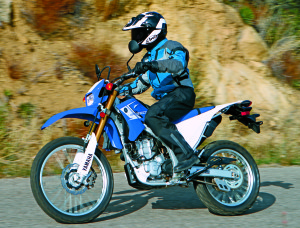
Chalk up some of it to the WR’s superior fire power. The fuel-injected mill uses 11.8:1 compression, titanium intake valves, high-lift cams and Yamaha’s electronically controlled intake and exhaust control valves to pack in the ponies. And it works—power builds quickly with a nice rush toward the 10,000 rpm peak. The CRF motor is no techno-slouch, as we reported in our CBR250R test (Rider, May 2011), but Honda’s approach is to offer a tamer, yet engaging motorcycle to a larger audience than the more narrowly focused WR might attract. Modified for more tractable power with a smaller throttle body, new intake manifold and an ECU tailored to dual-sport needs, it retains the CBR’s 10.7:1 compression ratio. Power is smooth and steady from the bottom up. Betwixt and between sits the carbureted KLX. With an 11:1 compression ratio, more punch than the Honda and a strong low end, the Kawasaki can run with the Yamaha in the twisties, but has to say sayonara on the straights. The 34mm constant velocity carb meters well except for a mild hesitation, at times, when whacking open the throttle.
Two long-time riding buddies joined me to hammer this trio on a day-long test ride covering everything from freeways to fire roads. I led the stampede up a tight mountain road on the Honda with the boys hard on my tail, stretching the throttle cable for any extra steam it could muster. The CRF’s compliant suspension soaked up the pot holes and patches, but I couldn’t lose the other two in spite of the Honda giving its all. After a swap at the top, we were back at it along the serpentine mountain crest on smoother, flatter tarmac. Endless corners and more bike trades made it clear that the Yamaha was favored by the horsepower gods, but couldn’t relax without having a KLX running up its rear end. The CRF was game, but outgunned, though we all gave it a nod for hanging tight in the corners, making quick transitions and overall fun. Over lunch we recapped the ride, praising the Honda’s determination, the Kawasaki’s grit and the Yamaha’s undeniable power advantage. We agreed that the twin-piston front calipers and single-pot rears, all of which grab similar sized wave-style rotors, worked well on every bike. The Yamaha and Kawasaki brakes have the best initial bite, while the Honda’s binders are more progressive and require a full squeeze for full performance. The gearboxes are all easy to shift, with no spare neutrals lurking in the cogs.
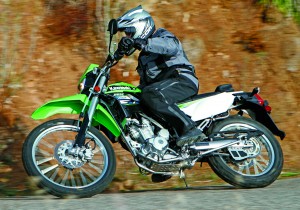
Bellies full, it was time to hit the dirt on a rough and rocky forest road to give the suspension a good workout. Still got the chalk handy? Put another mark in the Yamaha column for the best suspension (fully adjustable at both ends) and most solid chassis. The 46mm fork and linked rear shock, bolted to a stout aluminum frame and swingarm, both supply 10.6 inches of travel. A bolt-on steel front cradle and rear subframe complete the structure. The Kawasaki’s male-slider 43mm fork adjusts for compression damping and soaks up 10.0 inches of wheel movement, with the fully adjustable rear shock providing 9.1 inches. A one-piece steel frame with aluminum swingarm holds the components. Both of them tracked well off the pavement and maintained their composure through endless hard hits, with the
Yamaha handing out the plushest ride. Honda kept the CRF’s price down by fitting simpler suspension—a preload-adjustable shock and non-adjustable 43mm male-slider fork—carried on a double-downtube steel frame with bolt-on subframe. There’s 8.7 inches of travel up front, 9.4 at the rear. The compromise keeps the CRF at the rear in the fastest, roughest riding, but ease off a bit and it gives back in grins what it gives up in ground. Finishing the day with a freeway run, the bikes easily handled 70 mph traffic, with the KLX the most stable at elevated speeds, and the buzziest. The front ends of the Honda and Yamaha felt vague in comparison. Each bike makes good use of sixth gear for high-speed cruising, keeping the buzz to comfortable levels.
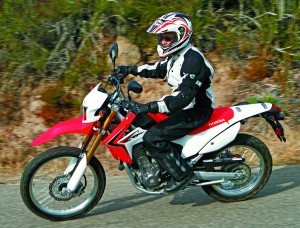
Climbing aboard this trio you’ll find the ergonomics are similar, except for seat heights. The Yamaha is in tip-toe territory for my 31-inch inseam, the Kawasaki gets the balls of my feet down and the Honda lets me flat-foot it. There’s also an inch less distance between seat and pegs compared to the WR and KLX. Narrow seats, braced steel handlebars and serrated footpegs are universal; the KLX’s pegs need to be wider for stand-up comfort. Electronic instrument pods include clocks and dual tripmeters, with the Kawasaki having the only tachometer and the Honda the only gas gauge (the Yamaha uses a fuel warning light). The most accurate speedo award goes to the Honda. The KLX and WR both read 72 mph at a GPS-measured 65 and got worse as speeds rose.
There’s a bike here for every budget and riding style, and all get excellent mileage and smileage (smiles per gallon). Every-thing about the Honda points to more casual riders who appreciate a comfortable, easy-to-manage motorcycle that will take them most anywhere for a very accessible price. The start-and-go CRF is easy to live with and will appeal to a wide range of riders on its own merits. Though it’s the heaviest of the group by 20-plus pounds, the weight isn’t a factor while riding. The Kawasaki begs to be ridden hard and put away dirty. Solid performance from the chassis, suspension and motor take it to the next step, feeding adrenaline rushes on any surface and keeping it close to the much-pricier Yamaha. Some carburetor tweaks or an upgrade to EFI to sort out the soft spot on quick throttle openings and eliminate its hard-to-reach enrichener and cold-blooded start-up performance would be worth a bump in price. Softening up the seat would be a bonus. The strongest performer overall, no matter the surface, is the Yamaha. But it’s not perfect—an annoyingly narrow clutch engagement point makes day-to-day riding more difficult and hinders clutch slipping in technical off-pavement work. It’s also cold-blooded, which is unusual for a fuel-injected machine. Still, the most serious riders—at least those with serious bank accounts—will buy the Yamaha, spin up the best 250cc motor we’ve seen, and never look back. Because if they do, there might be a KLX250S nipping at their knobs.
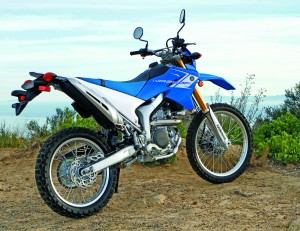
2013 Yamaha WR250R
Website: yamaha-motor.com
Base Price: $6,690
Engine Type: Liquid-cooled single, DOHC w/ 4 valves & EFI
Bore x Stroke: 77.0 x 53.6mm
Displacement: 250cc
Transmission: 6-speed,
wet multi-plate clutch
Final Drive: Chain (#520, 13T/43T)
Wheelbase: 55.9 in.
Rake/Trail: 26.7 degrees/4.4 in.
Seat Height: 36.6 in.
Claimed Wet Weight: 295 lbs.
Fuel Capacity: 2.0 gals. (1.9 in CA)
MPG: 91 PON min. (high/avg/low) 64.0/55.8/52.5
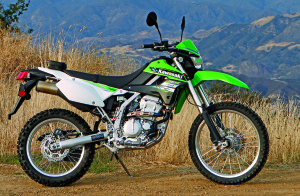
2013 Kawasaki KLX250S
Website: kawasaki.com
Base Price: $5,099
Engine Type: Liquid-cooled single, DOHC w/ 4 valves & 34mm CVK carburetor
Bore x Stroke: 72.0 x 61.2mm
Displacement: 249cc
Transmission: 6-speed w/wet multi-plate clutch
Final Drive: Chain (#520, 14T/41T)
Wheelbase: 56.3 in.
Rake/Trail: 26.5 degrees/ 4.1 in.
Seat Height: 35.0 in.
Claimed Wet Weight: 298 lbs.
Fuel Capacity: 2.0 gals.
MPG: 87 PON min. (high/avg/low) 61.5/54.5/50.4
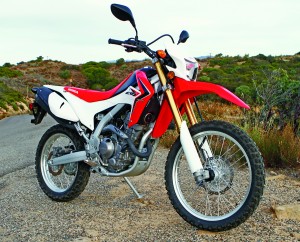
2013 Honda CRF250L
Website: powersports.honda.com
Base Price: $4,499
Engine Type: Liquid-cooled single, DOHC w/ 4 valves & EFI
Bore x Stroke: 76.0 x 55.0mm
Displacement: 249cc
Transmission: 6-speed w/ wet multi-plate clutch
Final Drive: Chain (#520, 14T/40T)
Wheelbase: 56.9 in.
Rake/Trail: 27.6 degrees/4.4 in.
Seat Height: 34.7 in.
Claimed Wet Weight: 320 lbs.
Fuel Capacity: 2.0 gals.
MPG: 87 PON min. (high/avg/low) 60.3/58.9/56.8
(This article Trick Ponies: 250 Dual Sport Shootout was published in the February 2013 issue of Rider magazine.)








just wondering why you picked the WR250R and not the XT250 to compare the CRF250L and KLX250S to, as that puts all the bikes at a similar price point. Isn’t that the point of value for dollar comparison?
thanks
PB
Did you bother to read even the first sentence?– “The last time Rider corralled a herd of 250 dual-sports (April 2008), we chose the thriftiest models available in the face of rising gas prices. This time we went for best-in-class”
Still torn between the KLX and CRF. The Yammy is very nice but that much money for a 250 is a no go in my book.
Riding KLX 250..needs a bit more
i have a crf250l and i say its the best bike of the 3 hehe
I have had the Honda CRF since January 2013 and have loved every minute of it. No regrets on or off road. Commuting at 75 mph, bounding through woody trails, whatever. Handles everything and gets 65-70 mpg.
Price alone is the problem.
Suzuki wants $6500 for the DR650 or DRZ400
$4200 for the DR200
Kawasaki wants $5100 for the KLX250s and $6500 for the 650
Honda wants $5000 for the CRF250 and $6700 for the XR650
Yamaha wants $5200 for the XT250 and $6700 for the WR250
Class 1
$6500-6700
WR250
DRZ400
DR650
KLR650
XR650
Class 2
$5000-$5200
KLX250
XT250
CRF250
Class 3
$4200
DR200
TW200
Wrong class comparison and all sites need this posted because they are all comparing Civic and a Focus to an Acura. Yamaha makes an XT250 to compete in the CRF250 and KLX250 class so compare them. Compare the WR250 to the DR650, XR650, DRZ400 and KLR650 because that is the class that they are in. Thank you now please delete the old ones. Please compare correctly.
Class dismissed.
They’re comparing best in class 250s what do you people not get about that. Stop complaining the wr250 is too much. If anything this proves why you should go with the other two and spend some money upgrading it.
Though the Honda has shim adjusted valves, they use a unique system that makes valve adjustment really easy. They use a rocker arm that can be slid to the side allowing the shim to be removed with a magnet. It’s the same system used on the Honda Ruckus. Way easier than having to remove cams to access the shim. I have never done shim type valves, but having watched the process on this Honda engine, I would not worry about doing it myself.
The KLX 250 seems to have disappeared from Kawasaki’s lineup. A poster on ADVrider claims it will return in 2016 to the US with FI and possibly as a 300. That would be a great bike but not holding my breath. Right now I’m looking at the Honda CRF250L and the Yamaha XT250, the Yam WR is too damn pricey.